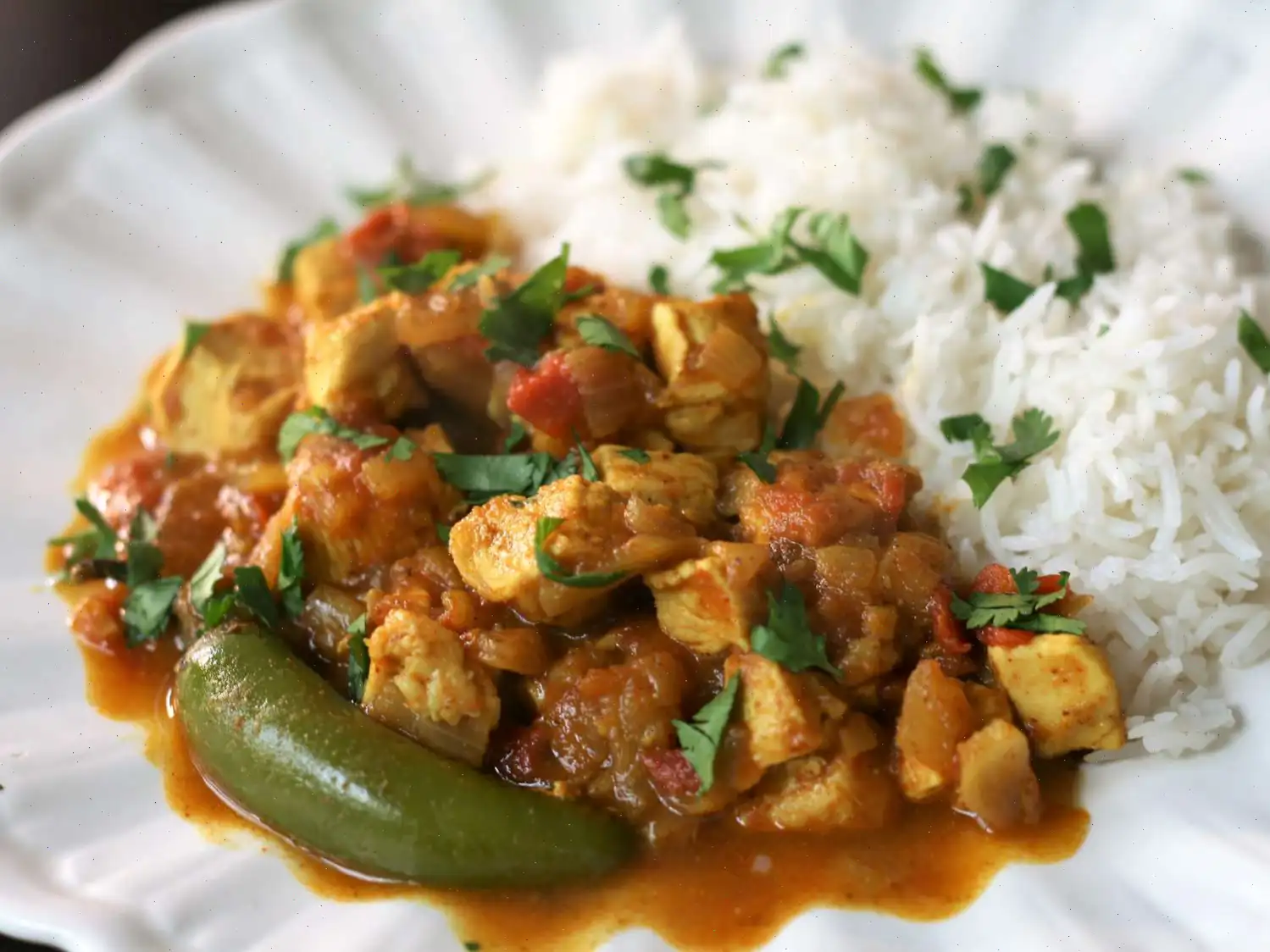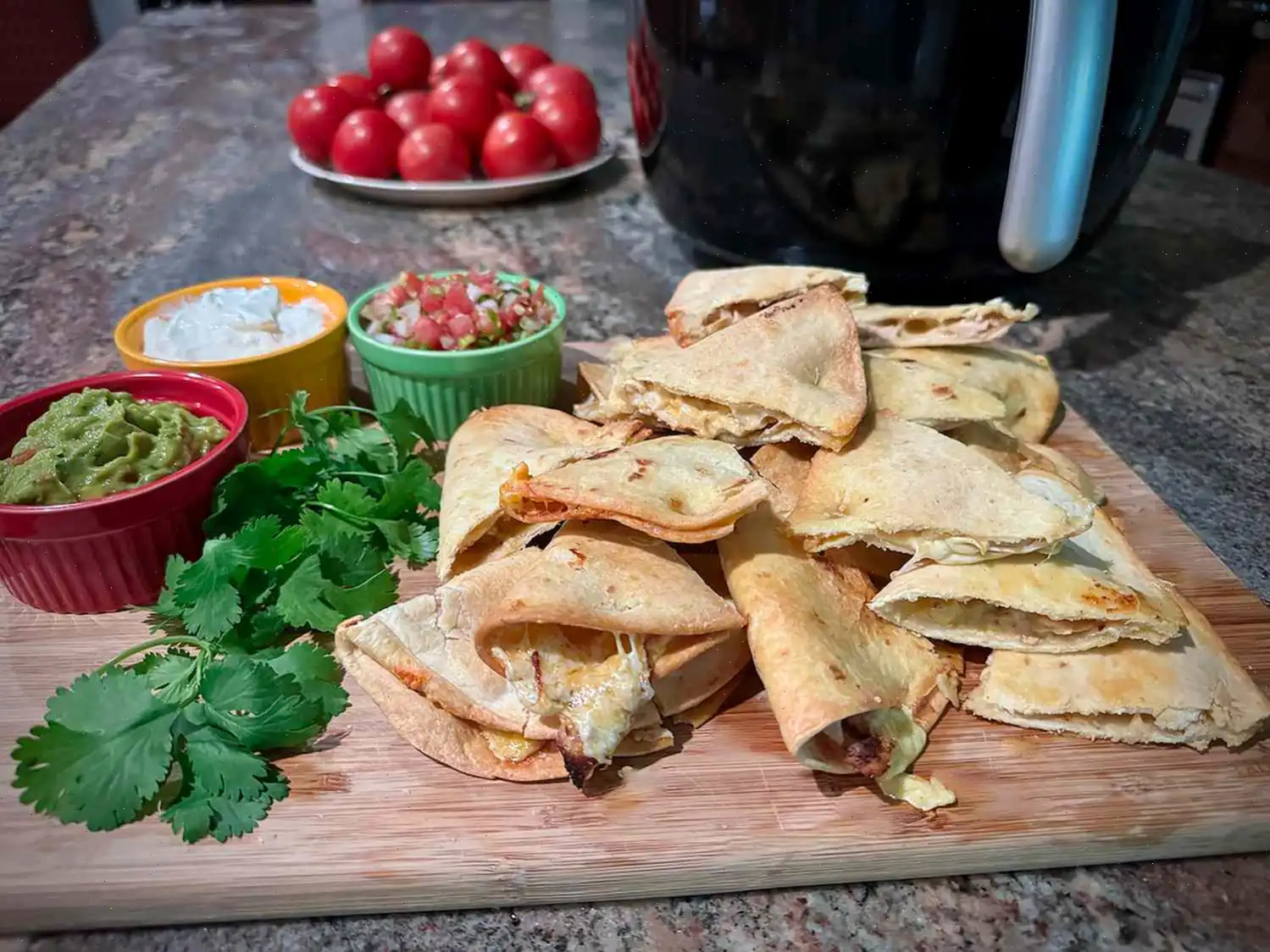
Chicken Bhuna Recipe
Ingredients
This recipe was originally developed to serve 4. Ingredient amounts adjust automatically, but cooking steps remain the same. Note that scaling may affect the final result.
- 2 tablespoons vegetable oil
- 3 medium onions, finely chopped
- 1 teaspoon salt
- 4 cloves garlic, crushed
- 1 tablespoon minced fresh ginger
- 1/4 cup hot water
- 1 teaspoon chili powder
- 1 teaspoon ground coriander
- 1 teaspoon ground cumin
- 1/2 teaspoon ground turmeric
- 2 medium tomatoes, chopped
- 2 green chiles, halved lengthwise (optional)
- 2 skinless, boneless chicken breast halves, cubed
- 1 teaspoon curry paste (such as Patak's)
- 1/4 cup fresh cilantro leaves, chopped
Directions
- Heat the vegetable oil in a nonstick pan over high heat. Add the chopped onions and salt, stirring frequently until the onions soften, about 5 minutes.
- Reduce the heat to low. Add the garlic and ginger, stirring until fragrant. Pour in the hot water, cover, and cook, stirring occasionally, until the water evaporates, roughly 5 minutes.
- Increase the heat to high again. Add chili powder, ground coriander, cumin, and turmeric. Stir continuously to toast the spices, about 5 minutes.
- Stir in the chopped tomatoes and green chiles (if using). Cover and simmer on low heat for 5 minutes.
- Add the cubed chicken. Cook over high heat, stirring occasionally, until the chicken is browned, 5-7 minutes.
- Mix in the curry paste, reduce heat to low, cover, and cook until the chicken is fully cooked, adding a splash of water if needed, approximately 5 minutes.
- Taste and adjust seasoning, then sprinkle with fresh chopped cilantro before serving.
Nutrition Facts (per serving)
| Calories | 183 |
|---|---|
| Total Fat | 9g (11%) |
| Saturated Fat | 1g (7%) |
| Cholesterol | 26mg (9%) |
| Sodium | 612mg (27%) |
| Total Carbohydrate | 16g (6%) |
| Dietary Fiber | 4g (13%) |
| Protein | 12g (24%) |
| Vitamin C | 27mg (30%) |
| Calcium | 55mg (4%) |
| Iron | 2mg (10%) |
| Potassium | 627mg (13%) |
*Percent Daily Values are based on a 2,000 calorie diet. Nutrient values may vary depending on ingredients and portion sizes. Consult a healthcare professional if following a medically restrictive diet.
History of Chicken Bhuna
Chicken Bhuna is a classic dish from the Indian subcontinent, rooted in Mughlai cuisine. The term bhuna refers to the cooking technique, which involves frying spices and onions in oil until they release their aroma, then simmering the ingredients to create a thick, flavorful sauce. Traditionally, this method was developed to make curries with intense, concentrated flavors without requiring large amounts of liquid, making it ideal for both royal kitchens and home cooking. Its origins are linked to the northern regions of India, where the fusion of Persian culinary techniques with local spices gave birth to rich, aromatic dishes like bhuna.
Regional Variations
While Chicken Bhuna is popular across India, there are subtle regional differences. In Bengal, the curry is slightly sweeter, with the addition of mustard oil and sometimes yogurt, giving it a unique tang. In Punjab, the dish often includes garam masala and fresh cream for a richer texture. Southern variations may feature curry leaves and coconut milk, creating a more fragrant and slightly milder version. Despite these differences, the hallmark of Bhuna remains the same: a thick, spicy gravy that clings to tender pieces of chicken.
Differences from Similar Dishes
Chicken Bhuna is often confused with other Indian curries, such as Chicken Masala or Chicken Korma, but it has distinct characteristics. Unlike Korma, which uses a creamy base with nuts or yogurt, Bhuna relies on sauted onions, garlic, ginger, and dry spices to develop flavor. Compared to typical curry dishes that may have a thinner gravy, Bhunas sauce is thicker and more intensely spiced due to the slow frying of the ingredients, which caramelizes the onions and deepens the flavor profile.
Where It Is Served
Chicken Bhuna is a versatile dish served in homes, restaurants, and street food stalls alike. It is a common feature on Indian restaurant menus around the world, often accompanied by steamed basmati rice, naan, or parathas. At home, it is typically prepared for special occasions or family dinners due to its rich flavor, which makes it an ideal centerpiece for meals that are shared among friends and relatives.
Interesting Facts
- The word bhuna comes from the Hindi verb bhunna, which means to fry or roast, emphasizing the technique over ingredients.
- Traditional Bhuna dishes use whole spices that are toasted and ground fresh for maximum aroma.
- In some Indian regions, leftover Bhuna is often reheated the next day, allowing the flavors to intensify even further.
- The dish is highly adaptable; you can replace chicken with lamb, beef, or vegetables while maintaining the signature thick, flavorful sauce.
- Despite being a curry, Chicken Bhuna uses very little water, making it one of the drier and more concentrated curry styles.
FAQ about Chicken Bhuna Recipe
Comments
Jose Scott
09/28/2025 01:12:18 PM
A satisfactory dish with delicious flavor. The authentic aroma of the spices really comes through, but I would suggest reducing the moisture from the onions. It's unlikely to evaporate completely.
Helen Davis
09/29/2025 01:01:56 AM
Review Update: The dish was undeniably delicious! However, I found that I needed to increase the amount of curry paste to enhance the flavor, and a touch of salt at the end. Despite these adjustments, the meal remained both tasty and nutritious. I did encounter some confusion with the instructions, as it seemed impractical to "toast" spices and "brown" chicken in a skillet filled with stewed vegetables – perhaps it would be more effective to cook them separately in a dry skillet. Additionally, the mention of "halved chiles" caused some uncertainty; in other chicken bhuna recipes I referred to, the chilies were minced. Are they primarily for flavor, or should they be removed at the end? I chose to serve this dish over basmati rice, and it was a delightful combination!
Heather Robinson
09/28/2025 06:45:21 PM
I decided to enhance the flavors by doubling the amount of curry paste in the recipe. Additionally, I substituted fresh tomatoes with canned chopped tomatoes and fresh chillies with crushed chilli paste.
Samantha Jones
09/28/2025 07:44:41 AM
This dish was mediocre at best. There were way too many onions in it! I never imagined I would complain about that since I usually enjoy onions. I am always cautious when a recipe calls for a whole onion, so I only included one, and I'm glad I did. Three would have been excessive. While the dish was decent (it's hard to dislike Indian cuisine), it lacked complexity and depth of flavor.
Nicholas Cruz
09/28/2025 11:41:05 PM
Extremely delicious, did not make any alterations








